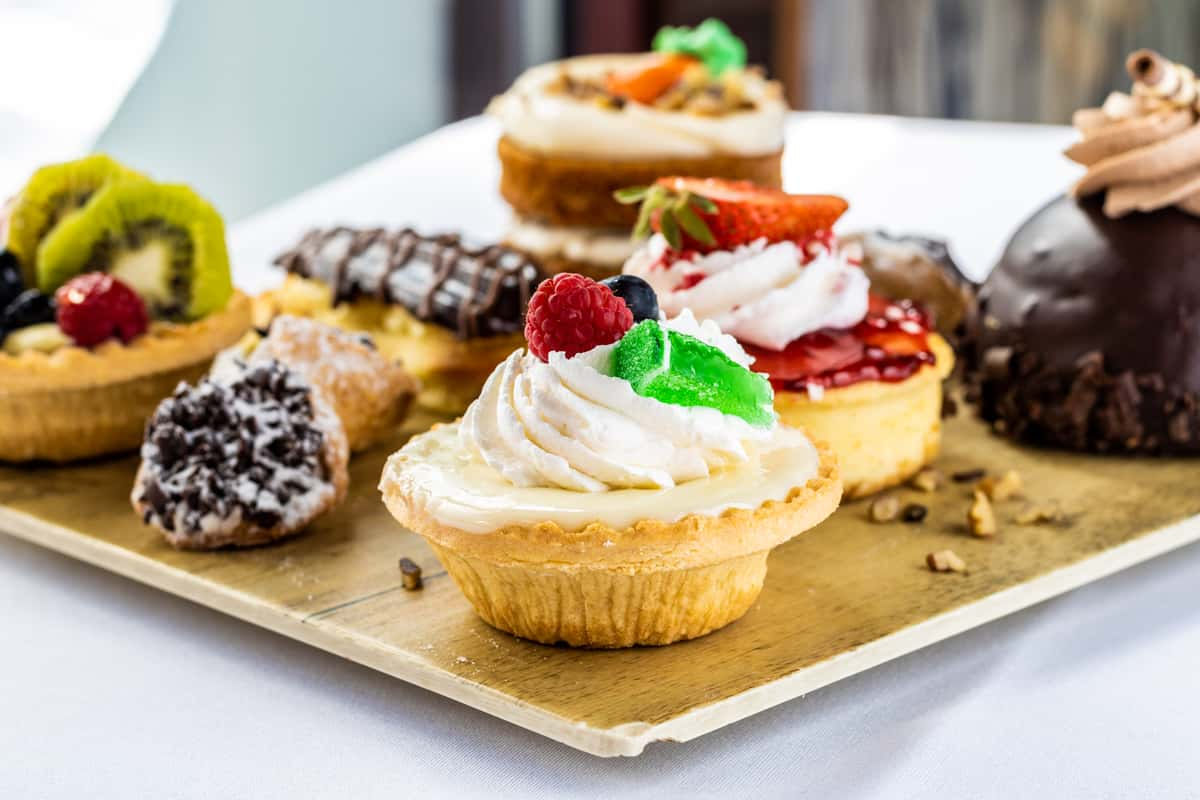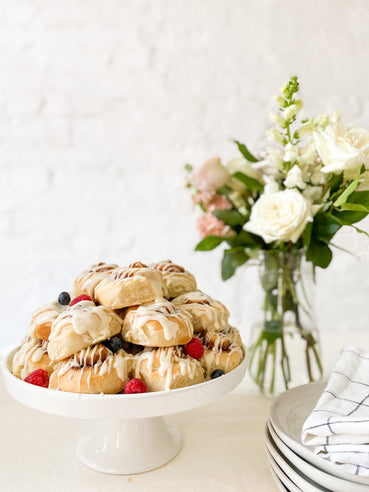Recognizing the Art of Bakery Products: From Newly Baked Breads to Tempting Pastries and Finger Foods
From the scientific research behind the best loaf of bread, where fermentation and gluten advancement play essential functions, to the finesse required for creating split breads, each facet exposes a compelling narrative of craftsmanship. The versatility of finger foods highlights just how taste and structure can be artfully combined to involve varied taste preferences.
The Scientific Research of Bread Making
At the heart of every loaf of bread lies a remarkable interplay of chemistry and biology. The procedure of bread making starts with the combination of flour, water, salt, and yeast-- each component playing an essential function in the last product.
Yeast, a living microorganism, ferments the sugars existing in the flour, producing carbon dioxide and alcohol while doing so. The carbon dioxide gas produces bubbles in the dough, creating it to climb and develop a light structure. The temperature level and humidity during fermentation dramatically influence yeast activity and, as a result, the bread's taste and texture.

Learning Pastry Strategies
Exactly how can one achieve the fragile balance of appearance and flavor that specifies outstanding pastry? Understanding pastry strategies requires a deep understanding of active ingredients, techniques, and the scientific research behind them. Essential to this craft is the option of top notch ingredients-- flour, butter, sugar, and eggs-- each playing a crucial function in the final product's taste and texture.
The strategy of lamination, which involves folding layers of dough and butter, produces the wanted flakiness in pastries like croissants and smoke bread. Precision in temperature level is vital, as butter needs to remain chilly to ensure ideal layers. In a similar way, proper mixing approaches, such as the creaming technique for cakes, guarantee also unification of air and fat, resulting in a light and ventilated crumb.
In addition, maintaining the best moisture degrees throughout cooking can considerably impact the result, ensuring that pastries rise properly and accomplish that golden-brown surface. The art of pastry likewise demands persistence and technique; each effort boosts one's ability and understanding of the detailed equilibrium called for to develop tempting breads that thrill the detects. Mastery in these methods eventually differentiates a proficient bread chef from an amateur.
Kinds Of Finger Foods
The world of culinary thrills expands past breads to include a broad range of finger foods, which are celebrated for their convenience and versatility. These bite-sized deals with are best for celebrations, using a range of flavors and textures that accommodate diverse palates.

On the sweeter side, tiny tarts and bite-sized cupcakes provide a wonderful coating to any kind of meal, attracting those with a craving for sweets. Cheese and charcuterie boards offer as a sophisticated choice, allowing guests to personalize their bites with a variety of meats, cheeses, nuts, and fruits.
Flavor Profiles in Baking
Baking is an intricate dance of flavor accounts that incorporates sweet, savory, Read Full Report and umami notes to create an unified experience for the taste. Recognizing these accounts is crucial for bakers looking for to boost their productions.
Sweet taste commonly acts as the foundation in baked goods, with sugars, fruits, and natural sugar boosting taste deepness. Components such this article as delicious chocolate and caramel introduce complex sweet notes that can either dominate or complement other tastes. Alternatively, full-flavored components, commonly discovered in breads and breads, provide balance and contrast. Ingredients like herbs, cheeses, and seasonings can change a straightforward dough right into a multifaceted flavor experience.
Umami, frequently forgotten in baking, plays a substantial function in improving flavors. Active ingredients such as aged cheeses, fermented products, or also specific nuts contribute to a full-flavored depth that improves overall preference.
Additionally, the interaction of level of acidity from components like buttermilk or citrus enthusiasm can brighten flavors, supplying a rejuvenating counterpoint to sweet taste. By thoughtfully integrating these taste profiles, bakers can craft products that reverberate with diverse tastes buds, developing a memorable cooking experience. Ultimately, grasping taste accounts is crucial to innovation on the planet of cooking.
Important Cooking Devices and Ingredients
Comprehending taste accounts in cooking sets the stage for choosing view it the right devices and active ingredients that help with the development of phenomenal baked goods. The foundation of successful baking depend on having crucial devices at your disposal. Key items include mixing bowls, determining cups, and spoons for accuracy, in addition to a strong stand mixer or hand mixer for easy mixing. A reputable collection of cooking pans-- such as sheet frying pans, loaf frying pans, and cake frying pans-- is critical for achieving preferred forms and appearances.
In terms of active ingredients, quality matters considerably. Flour works as the foundation of most recipes; selecting the appropriate type-- be it all-purpose, bread, or pastry flour-- can drastically affect the result. Sugar not only sweetens but additionally contributes to texture, while eggs work as binders and leavening representatives. Cooking powder and baking soft drink are vital for creating lift in cakes and breads.
In addition, incorporating taste enhancers like vanilla essence, seasonings, and citrus passion can boost your creations. By making certain access to these basic tools and components, bakers can with confidence begin on their cooking trip, crafting a diverse variety of delightful baked products.
Verdict
In conclusion, the art of bakeshop items encompasses a profound understanding of both imaginative techniques and scientific principles. Proficiency in bread production, bread preparation, and finger food presentation exposes the detailed partnerships between processes and ingredients. Discovering varied taste accounts improves the baking experience, while essential devices and ingredients provide the foundation for success. Ultimately, the enchanting world of baking thrives on the harmonious interplay of scientific research and creative thinking, resulting in a myriad of fascinating cooking productions.
Just how can one attain the delicate balance of texture and taste that defines outstanding pastry? Basic to this craft is the option of top notch components-- flour, butter, sugar, and eggs-- each playing an important role in the last item's flavor and appearance.

Understanding taste accounts in cooking sets the stage for selecting the right tools and components that assist in the creation of outstanding baked goods. Discovering diverse flavor profiles enhances the baking experience, while necessary devices and active ingredients give the structure for success.